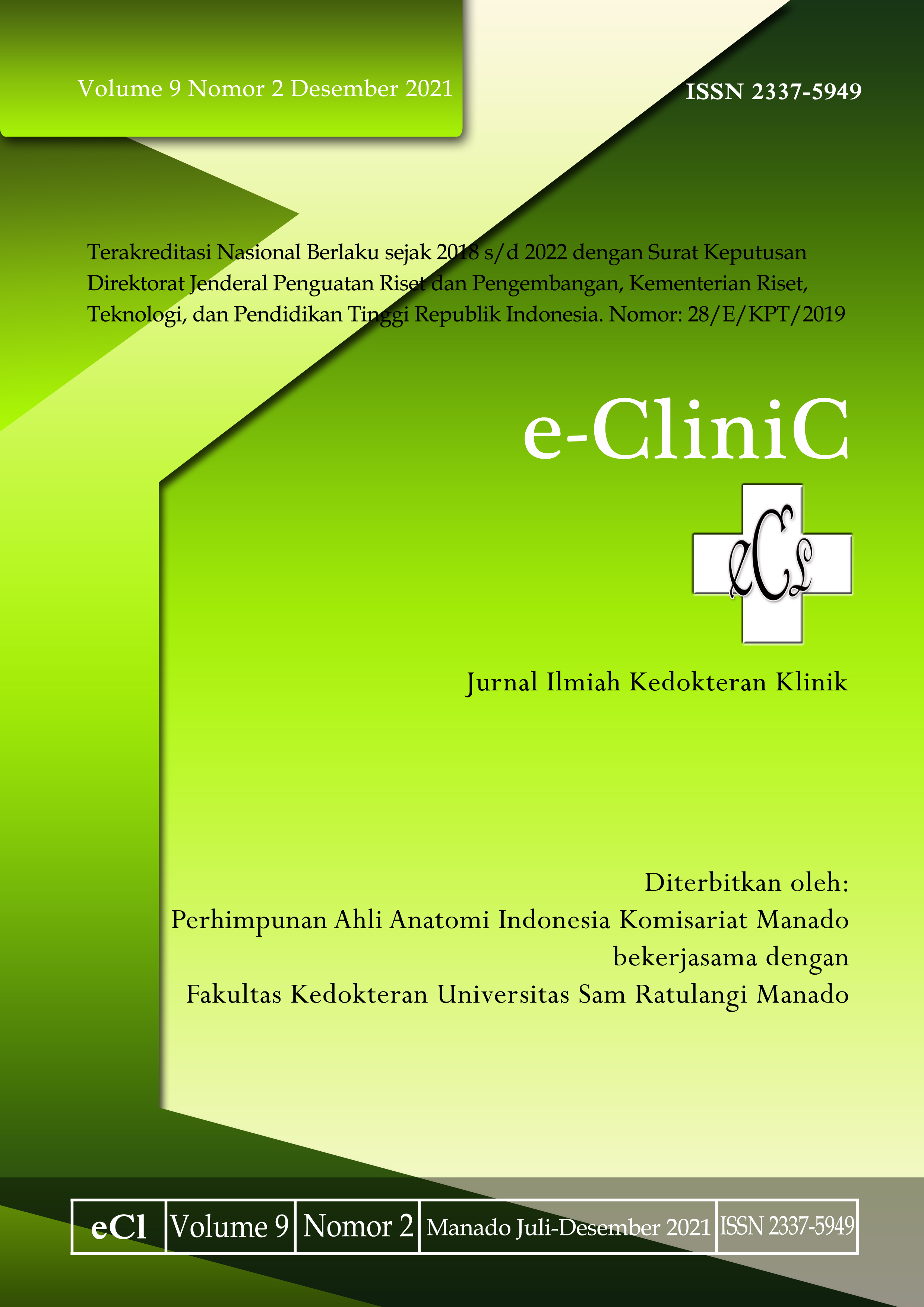Terapi Reperfusi pada Infark Miokard dengan ST-Elevasi
DOI:
https://doi.org/10.35790/ecl.v9i2.32850Abstract
Abstract: Myocardial infarction is classified into ST-segment elevation myocardial infarction (STEMI) and Non-ST-segment elevation myocardial infarction (NSTEMI). STEMI patient is considered for a reperfusion therapy, consisting of percutaneous coronary intervention (PCI), fibrinolytic therapy, and coronary artery bypass grafting (CABG). This study was aimed to determine the effectiveness of reperfusion therapy in STEMI patients. This was a literature review study. The results described the effectiveness of reperfusion therapy in terms of the time action, as follows: effective PCI if <120 minutes, fibrinolytic therapy <90 minutes, and CABG within four to 30 days after angiography. In case of revascularization with PCI there was a decrease in mortality and complications of reinfarction, major bleeding, and stroke. There was a reduction in complications of cardiogenic shock with fibrinolytic therapy when given within the first 60 minutes of symptom onset. Fibrin-spesific fibrinolytics (accelerated infusion alteplase, tenecplase, and reteplase) were the most effective regimen associated with reduced mortality. CABG procedure is recommended in coronary anatomical conditions that was not suitable for PCI and several other indications; although the complications were high but the survival of 30 days and one year was very good. In conclusion, PCI is the first line choice and effective if performed less than the first 120 minutes. Fibrinolytics are effective if they are administered during the first 60 minutes in case the PCI is not performed. Moreover, CABG is recommended in anatomical coronary condition that is not suitable for PCI and other indications.
Keywords: reperfusion therapy, acute myocardial infarction, STEMI
Â
Â
Abstrak: Infark miokard diklasifikasikan atas ST-segment elevation myocardial infarction (STEMI) dan Non-ST-segment elevation myocardial infarction (NSTEMI). Pada pasien STEMI diper-timbangkan untuk dilakukan terapi reperfusi yang terdiri dari percutaneous coronary intervention (PCI), terapi fibribolitik, dan coronary artery bypass grafting (CABG). Penelitian ini bertujuan untuk mengetahui efektivitas terapi reperfusi pada pasien STEMI. Jenis penelitian ialah literature review. Hasil penelitian ini menjelaskan efektivitas terapi reperfusi ditinjau dari waktu tindakan. Tindakan PCI efektif dilakukan <120 menit, terapi fibrinolitik <90 menit, dan CABG dalam empat hingga 30 hari setelah angiografi. Pada kasus revaskularisasi dengan tindakan PCI terdapat penurunan mortalitas dan komplikasi reinfark, perdarahan mayor, dan stroke. Terdapat penurunan komplikasi syok kardiogenik pada terapi fibrinolitik bila diberikan dalam 60 menit pertama setelah onset gejala. Fibrin-spesific fibrinolytics (accelerated infusion alteplase, tenecplase, dan reteplase) merupakan regimen yang paling efektif dikaitkan dengan penurunan mortalitas. Tindakan CABG direko-mendasikan pada kondisi anatomi koroner yang tidak sesuai untuk PCI dan beberapa indikasi lain; meskipun komplikasi tinggi namun kelangsungan hidup 30 hari dan satu tahun sangat baik. Simpulan penelitian ini ialah tindakan PCI merupakan pilihan lini pertama dan efektif diberikan dalam waktu <120 menit. Fibrinolitik efektif diberikan dalam 60 menit pertama bila PCI tidak dapat dilakukan sedangkan tindakan CABG direkomendasikan pada kondisi anatomi koroner yang tidak sesuai untuk PCI dan beberapa indikasi lain.
Kata kunci: terapi reperfusi, infark miokard akut, STEMI
Downloads
Published
How to Cite
Issue
Section
License
COPYRIGHT
Authors who publish with this journal agree to the following terms:
Authors hold their copyright and grant this journal the privilege of first publication, with the work simultaneously licensed under a Creative Commons Attribution License that permits others to impart the work with an acknowledgment of the work's origin and initial publication by this journal.
Authors can enter into separate or additional contractual arrangements for the non-exclusive distribution of the journal's published version of the work (for example, post it to an institutional repository or publish it in a book), with an acknowledgment of its underlying publication in this journal.
Authors are permitted and encouraged to post their work online (for example, in institutional repositories or on their website) as it can lead to productive exchanges, as well as earlier and greater citation of the published work (See The Effect of Open Access).







